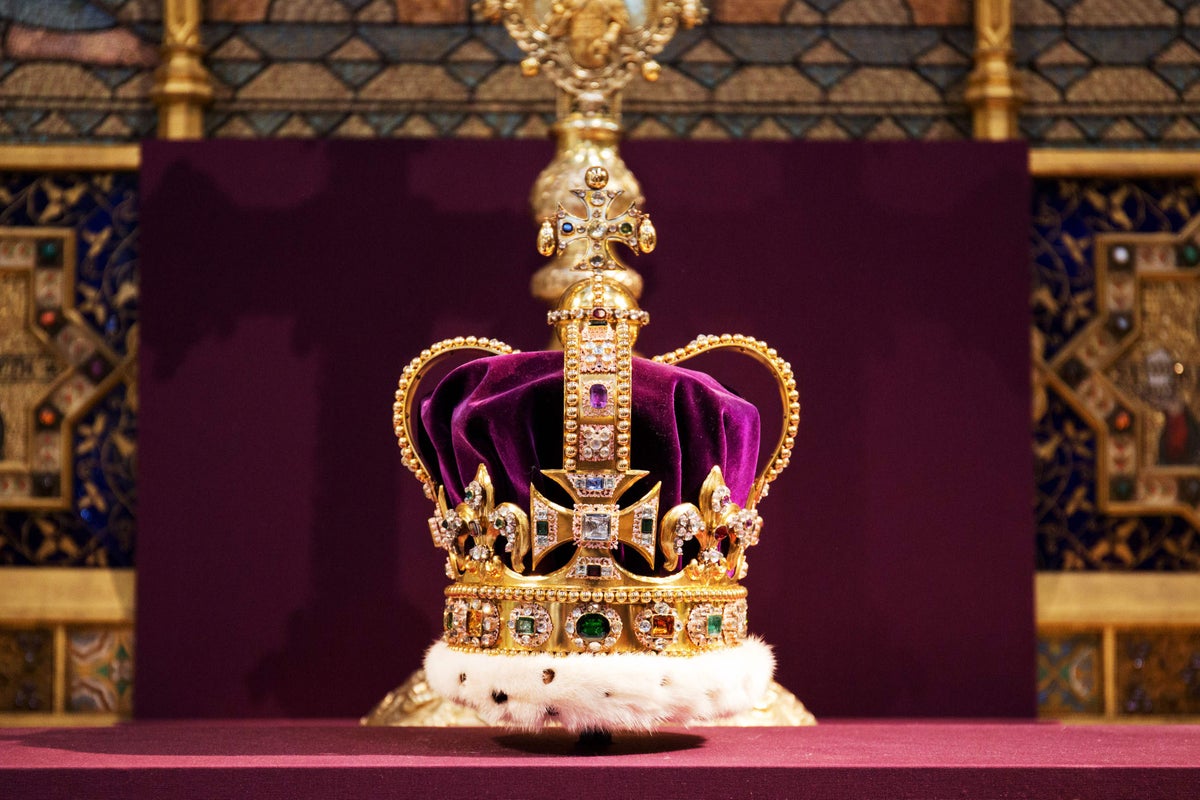
The centrepiece of King Charles’ coronation is a lavish ceremony in Westminster Abbey.
Charles and Camilla were welcomed at the abbey’s great west door by the Archbishop of Canterbury Justin Welby on Saturday after they travelled through the capital’s streets in a carriage procession.
The King is the 40th reigning monarch to be crowned at the abbey, the nation’s coronation church, since William the Conqueror was anointed monarch within its walls on Christmas Day 1066.
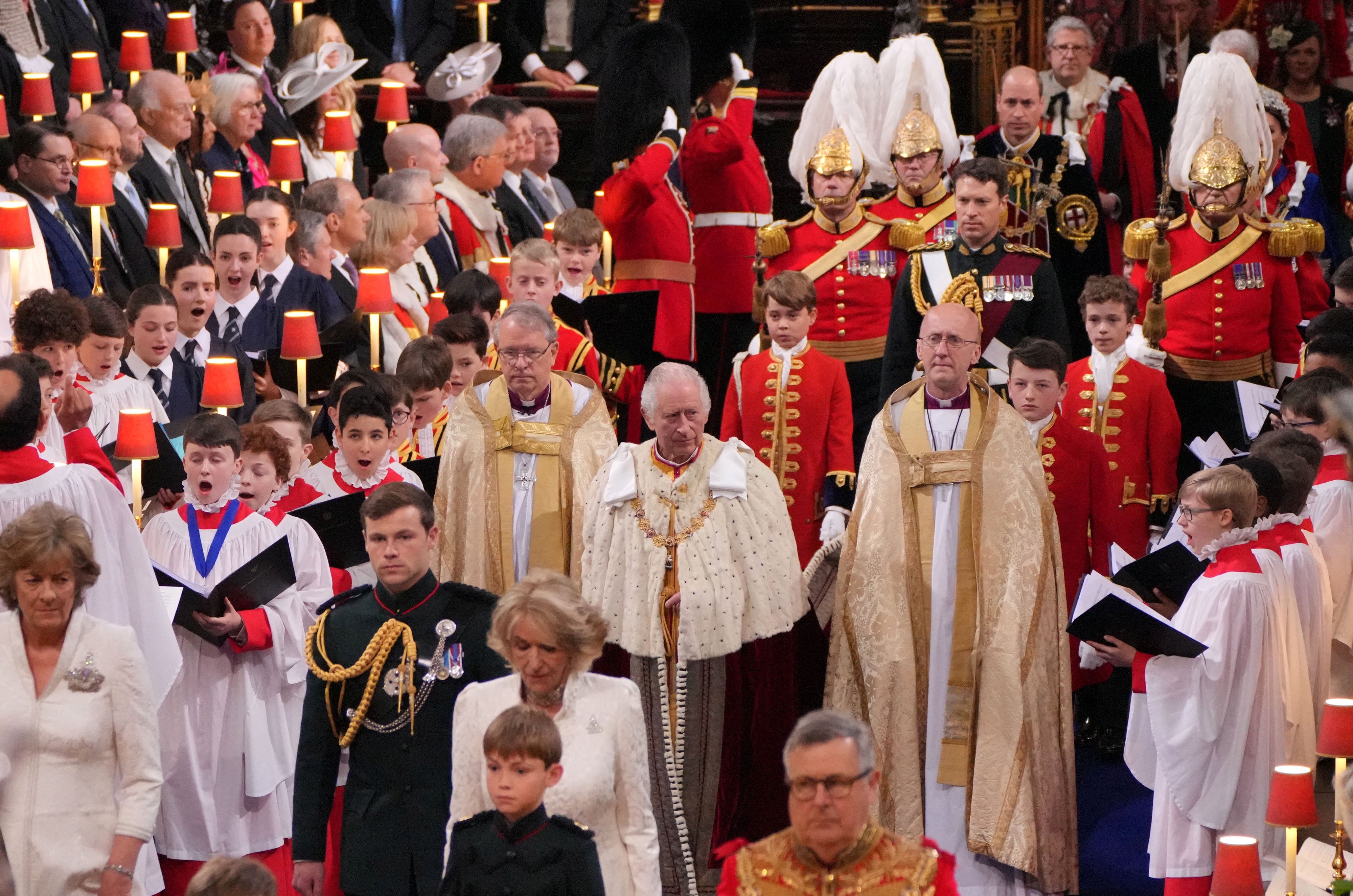
The service has included a number of priceless objects that are part of the Crown Jewels, held in trust by the King for the country and kept under armed guard in the Tower of London.
Below is a guide to the regalia on display.
PROCESSION
Two ceremonial maces
Maces – based on medieval weapons – are used in royal processions to symbolise royal authority and will be carried before the sovereign on his way to Westminster Abbey.
They are club-like, topped with crown arches and made of silver gilt over oak.
They date between 1660 and 1695, and are also used at the State Opening of Parliament.
St Edward’s Staff
St Edward’s Staff, also known as the Long Sceptre, has a pike of steel at the bottom and is carried as part of the procession into the abbey.
Most of the original ancient coronation regalia was destroyed by Oliver Cromwell during the English Civil War and remade during the reign of Charles II, including the staff which was a relic associated with Edward the Confessor.
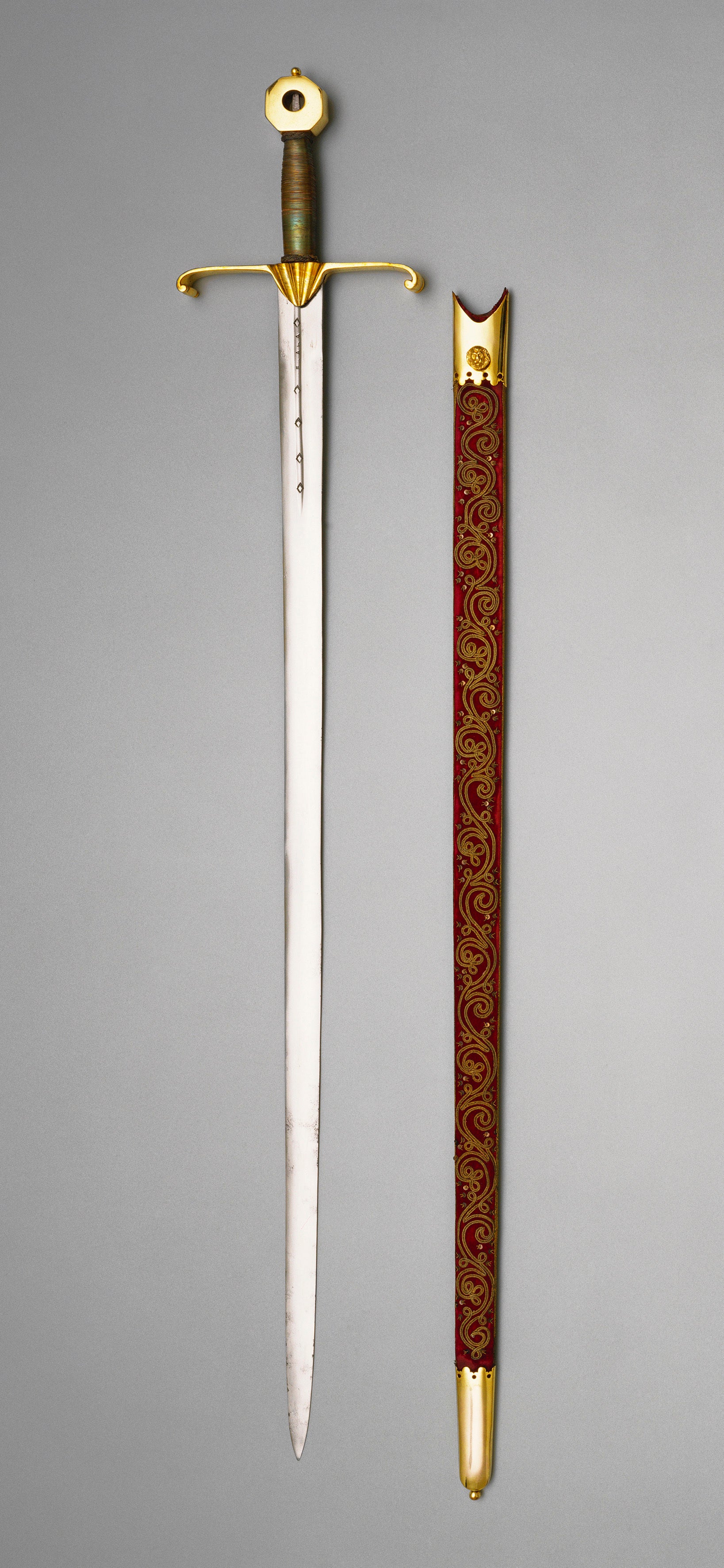
Swords of Temporal Justice, Spiritual Justice and Mercy
The practice of carrying three swords, representing kingly virtues, dates back to the coronation of Richard the Lionheart in 1189.
The Sword of Temporal Justice signifies the monarch’s role as Head of the Armed Forces, the Sword of Spiritual Justice symbolises the King as Defender of the Faith, and the Sword of Mercy, also known as the Curtana, has a blunted tip to symbolise the sovereign’s mercy.
They are carried pointing upwards, unsheathed without their scabbards, in the coronation procession in the abbey.
Together with the Coronation Spoon, the three swords – which date from the reign of Charles I – were the only pieces of the coronation regalia to survive the Civil War.
Sword of State
The 17th-century Sword of State is carried in procession to the abbey.
Its silver-gilt hilt features the form of a lion and unicorn and the wooden scabbard is covered in red velvet with silver-gilt rose, thistle and fleur-de-lis emblems.
It is also carried during the State Opening of Parliament.
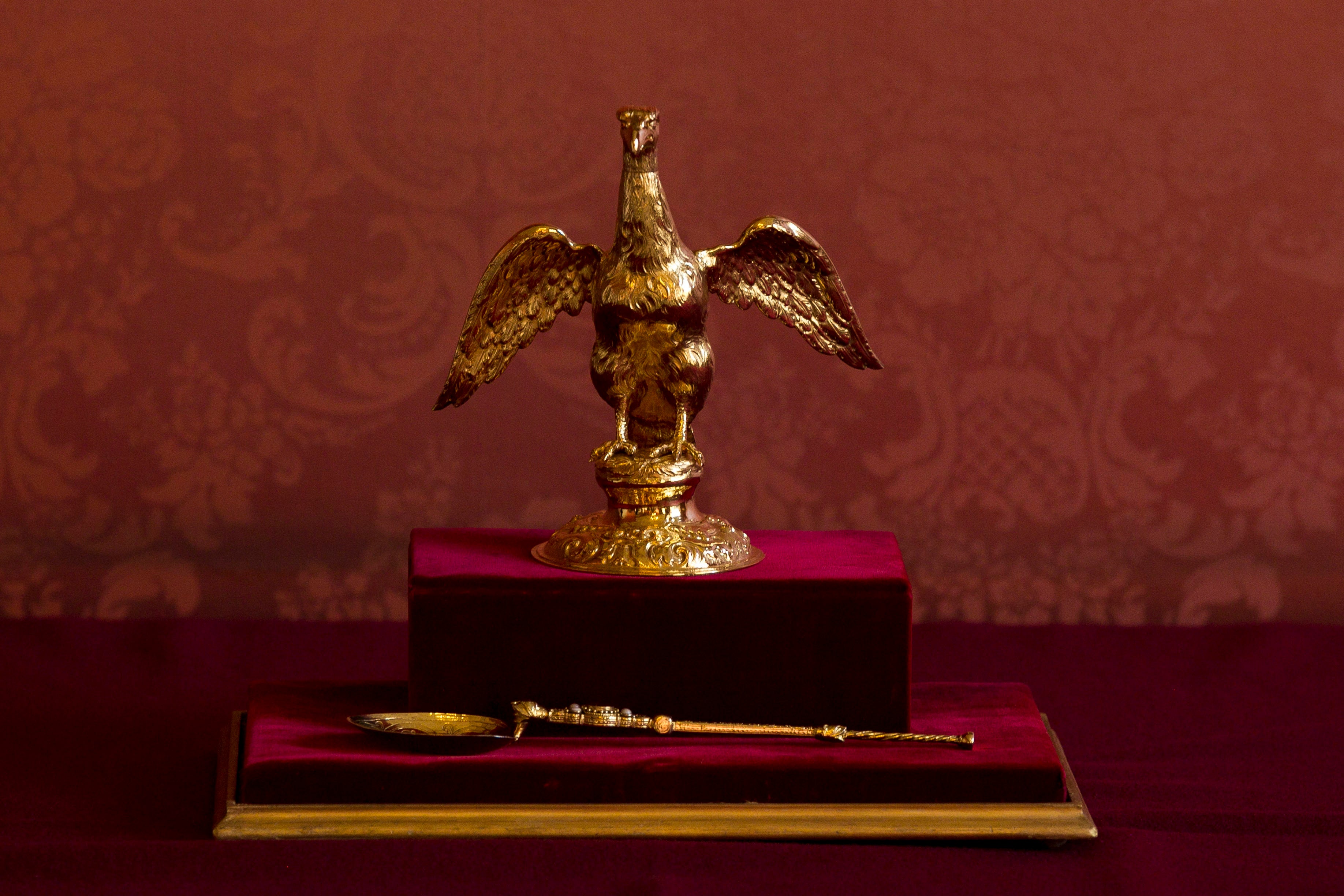
THE ANOINTING
Ampulla
The anointing of the King with holy oil is the most sacred part of the ceremony.
The gold Ampulla is shaped in the form of an eagle with outspread wings and is used to hold the consecrated oil.
There is an opening in the beak for pouring the oil on to the Coronation Spoon.
It is based on an earlier smaller vessel which took inspiration from a 14th-century legend saying the Virgin Mary appeared to St Thomas Becket in a dream and presented him with a golden eagle and a vial of oil for anointing future kings of England.
Coronation Spoon
The 12th-century spoon is considered the “most humble” but the oldest object in the Crown Jewels.
The blessed oil is poured into the bowl or head of the spoon to allow the Archbishop to dip his fingers into it.
He will privately anoint the King, hidden by a screen, with the sign of the cross on his hand, his breast and his head, and then later anoint Camilla.
The King will have taken off his crimson Robe of State and be dressed in a simple white shirt for the anointing.
The Coronation Spoon survived Parliament’s destruction of the Crown Jewels in 1649 because it was bought by a royal servant in a sale of the executed Charles I’s goods and later returned to Charles II.
Made of silver gilt, it has an oval bowl which is engraved with acanthus scrolls and divided into two lobes – allowing enough space for two fingers to be used for dipping.
Its stem features two stylised monsters’ heads, pearls and interlaced scrolling.
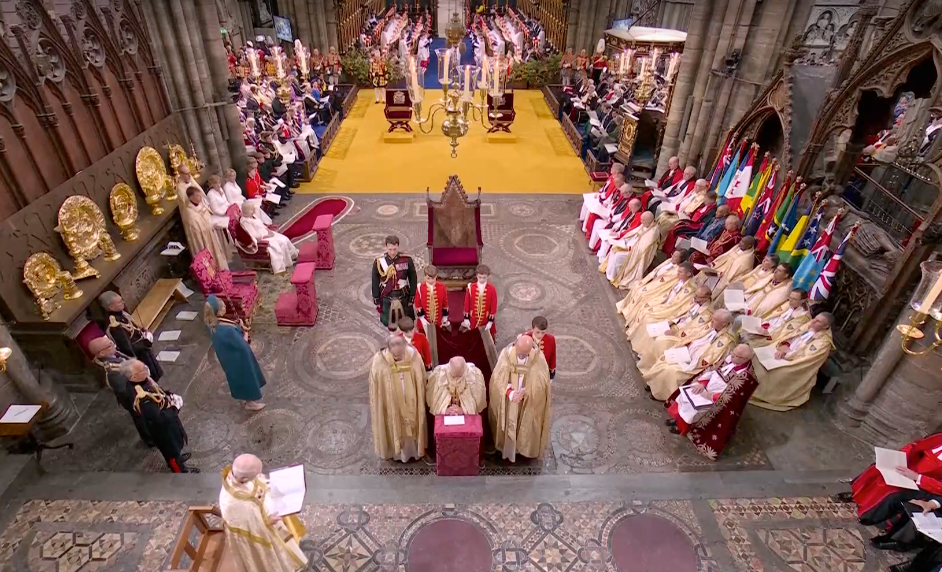
Colobium Sindonis, Supertunica and Coronation Girdle
After his anointing, the King will put on a sleeveless white garment called the Colobium Sindonis – Latin for shroud tunic.
On top will go a long shimmering gold-sleeved coat called the Supertunica, created for his great-grandfather George V in 1911, and worn at successive coronations including by Elizabeth II.
Made of cloth of gold, which is silk thread wrapped in thin pieces of gold or silver gilt metal, the Supertunica, also known as the Close Pall of Cloth of Gold, weighs around 2kg and is embroidered with stylised arabesques and floral motifs.
Around his waist, on top of the Supertunica, goes the Coronation Sword Belt also known as the Coronation Girdle, which is embroidered cloth of gold with a gold buckle stamped with national emblems.
It has a gold clip used for briefly attaching the Jewelled Sword of Offering.
The glittering coronation vestments are inspired by priestly attire.
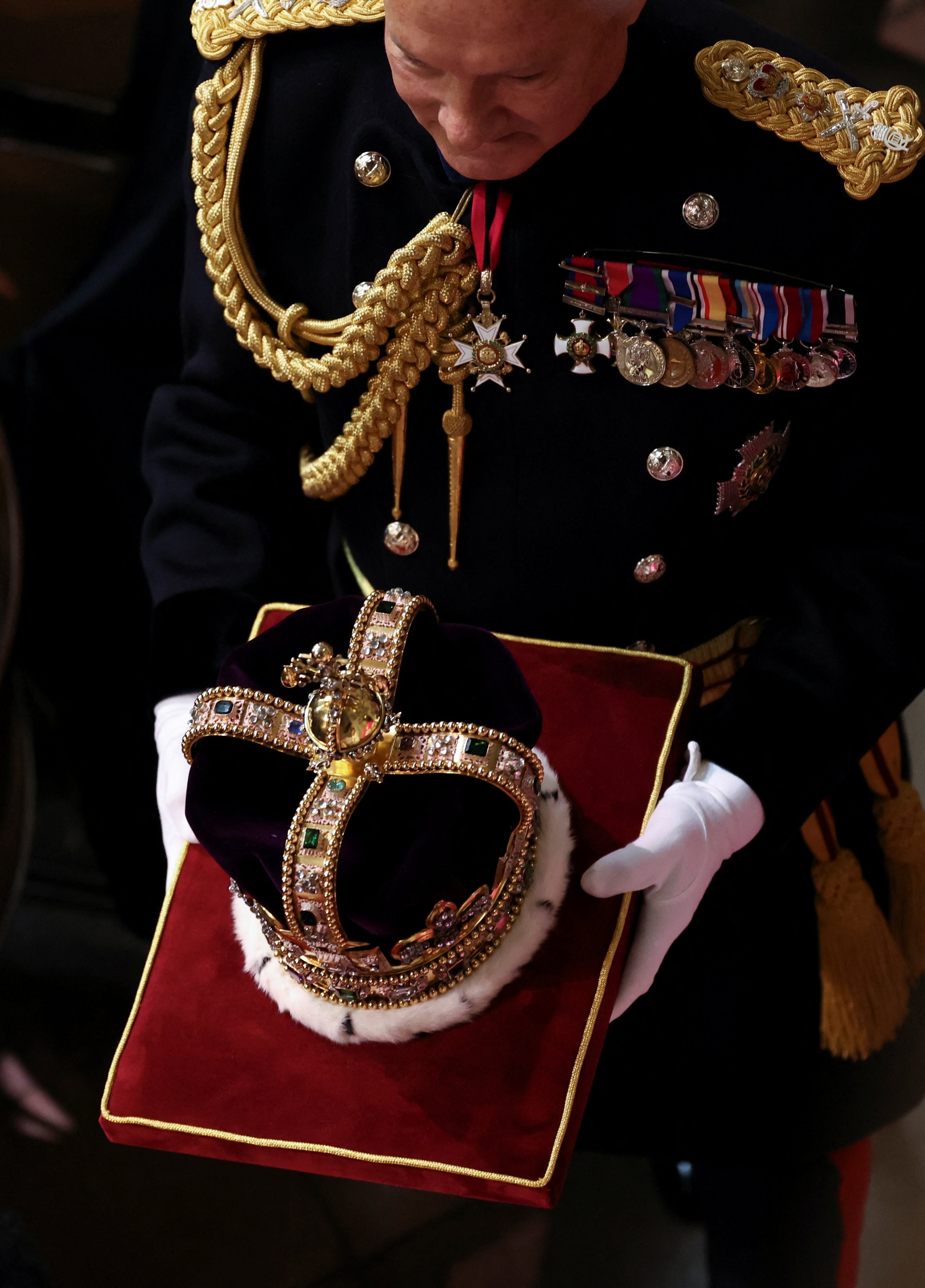
THE INVESTITURE
The investiture part of the coronation is when the King is given all the symbolic objects representing his powers and responsibilities.
It stems from medieval times when coronation ceremonies were in Latin, with the symbols ensuring those in the audience who could not speak Latin could interpret their meaning.
Golden Spurs
Each of the gold spurs features a Tudor rose and velvet-covered strap with gold embroidery.
Traditionally, the spurs were fastened to the sovereign’s feet during a coronation and in later times held briefly to the ankles of kings or presented to a queen for her to touch, and then placed on the altar.
The King will instead acknowledge the spurs, presented by the Lord Great Chamberlain, before they are returned to the altar.
They were made for Charles II and symbolise knighthood and chivalry.
Jewelled Sword of Offering
The intricate tapered sword, made for George IV’s 1821 coronation, has a hilt encrusted with diamonds, rubies and emeralds and a scabbard decorated with jewelled roses, thistles and shamrocks.
Lord President of the Council Penny Mordaunt will present it to the monarch, becoming the first woman in history to do so.
It will be briefly clipped to the King’s coronation sword belt and then after a proclamation by the Archbishop, the King will step forward and offer up the sword.
It will be placed on the altar, and redeemed with “redemption money” by Ms Mordaunt.
The sword is then drawn and she carries it in its “naked” form – without its scabbard – before the monarch for the rest of the service.
It symbolises royal power and being able to decide between good and evil, and the monarch accepting his duty and knightly virtues.
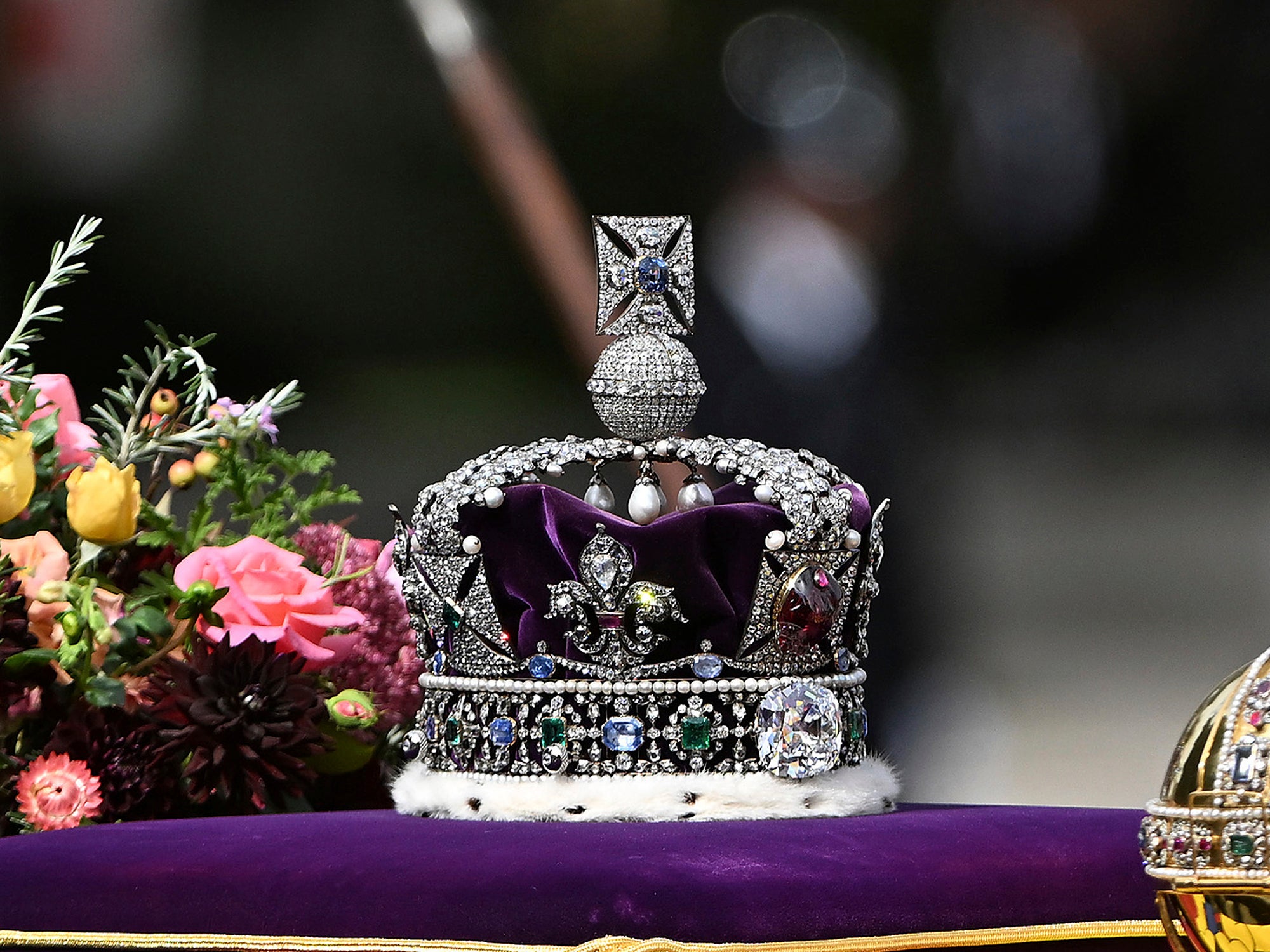
Armills
Golden armlets – known as Armills – used to be placed on the sovereign’s wrists, but the King will acknowledge them instead.
They will be carried to the monarch by Lord Kamall, a British-born Muslim, before being returned to the altar.
They are known as the “bracelets of sincerity and wisdom” and are thought to relate to ancient symbols of knighthood and military leadership.
New Armills were prepared for the coronation of Elizabeth II as a gift from the Commonwealth, replacing the previous pair, which had been used since 1661.
But the King will use the original pair last used by his grandfather, George VI.
They are decorated with national emblems – roses, thistles, fleurs-de-lis and harps – dark blue fleurets and red pellets, and lined in red velvet.
The Robe Royal and Stole Royal
The King will be given a Stole Royal – also known as the Coronation Stole – which is a long, narrow embroidered band of gold silk which goes around the shoulders, mirroring outfits worn by a priest or a bishop.
The King will next be dressed in the Imperial Mantle – or Robe Royal – made for his extravagant ancestor George IV in 1821.
Made from cloth of gold, it is brocaded with colourful motifs including fleur-de-lis as a nod to the ancient claim of England over France, as well as imperial eagles, and national floral emblems of red-pink roses, blue thistles and green shamrocks.
The mantle is inspired by ancient coronation ensembles and its representation of priestly robes symbolises the divine nature of kingship.
Heir to the throne the Prince of Wales enters the coronation theatre to assist with placing the robe on his father, as does Baroness Gillian Merron, who served as the Board of Deputies of British Jews’ chief executive for more than six years.
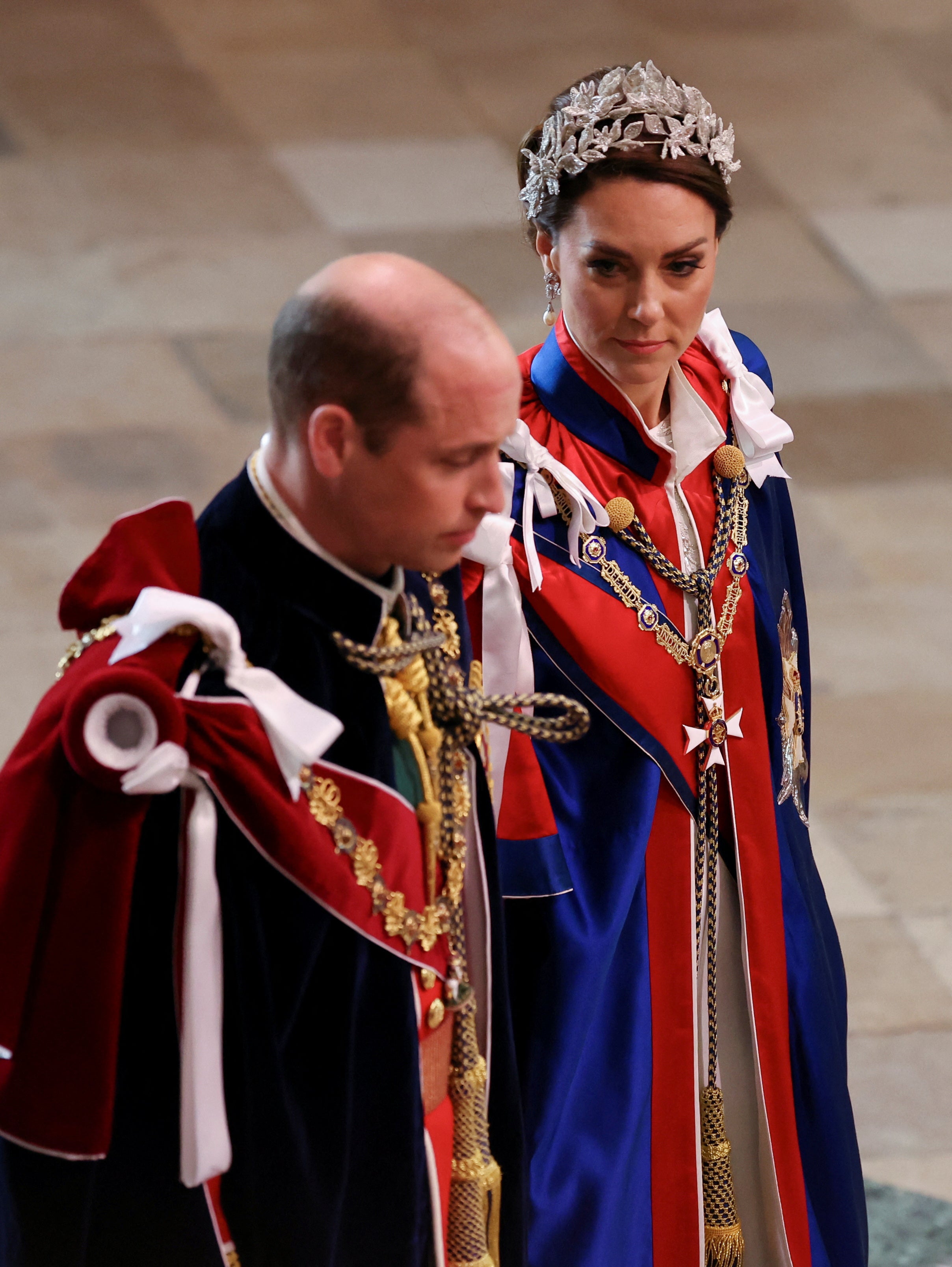
Sovereign’s Orb
The Sovereign’s Orb, with its cross mounted on a golden globe, symbolises that the monarch’s power is derived from God.
It is decorated with clusters of emeralds, rubies and sapphires surrounded by rose-cut diamonds, and single rows of pearls, with the bands of jewels dividing it into three sections representing the three continents known in medieval times.
During the coronation service, the Orb – which weighs 1.3kg and dates back to 1661 – is placed in the monarch’s right hand by the Anglican Archbishop of Armagh.
It is then put on the altar before the moment of crowning.
Sovereign’s Ring
Known as the “Wedding Ring of England”, the Sovereign’s Ring – also called the Coronation Ring – is a symbol of “kingly dignity” and it marries the King to God in duty.
It used to be placed on the fourth finger of the monarch’s right hand, but the King will instead acknowledge it before it is returned to the altar. It will be presented by Lord Patel.
A new ring used to be made for each king or queen, but for nearly 200 years monarchs have used William IV’s 1831 ring – except for Queen Victoria whose fingers were too small so she had a new one made.
William IV’s ring features a large sapphire and diamond cluster with baguette-cut rubies in the form of a cross.
The rubies represent the cross of the patron saint of England St George and the sapphire is said to represent the Scottish flag.
Coronation Glove
The single Coronation Glove – also known as the Coronation Gauntlet – goes on the King’s right hand while he holds the Sovereign’s Sceptre with Cross during the crowning.
It is made of white leather, and the large cuff is embroidered with gilt metal thread, wire and spangles in the form of national emblems including the Tudor rose, thistle, shamrock, oak leaves and acorns.
The back of the hand has an embroidered ducal coronet above the coat of arms of the family of the Dukes of Newcastle.
Charles, for reasons of sustainability and efficiency, has decided to reuse the glove worn by his grandfather – the last male monarch – George VI.
Prominent Sikh broadcaster Lord Singh of Wimbledon presents the King with the glove.
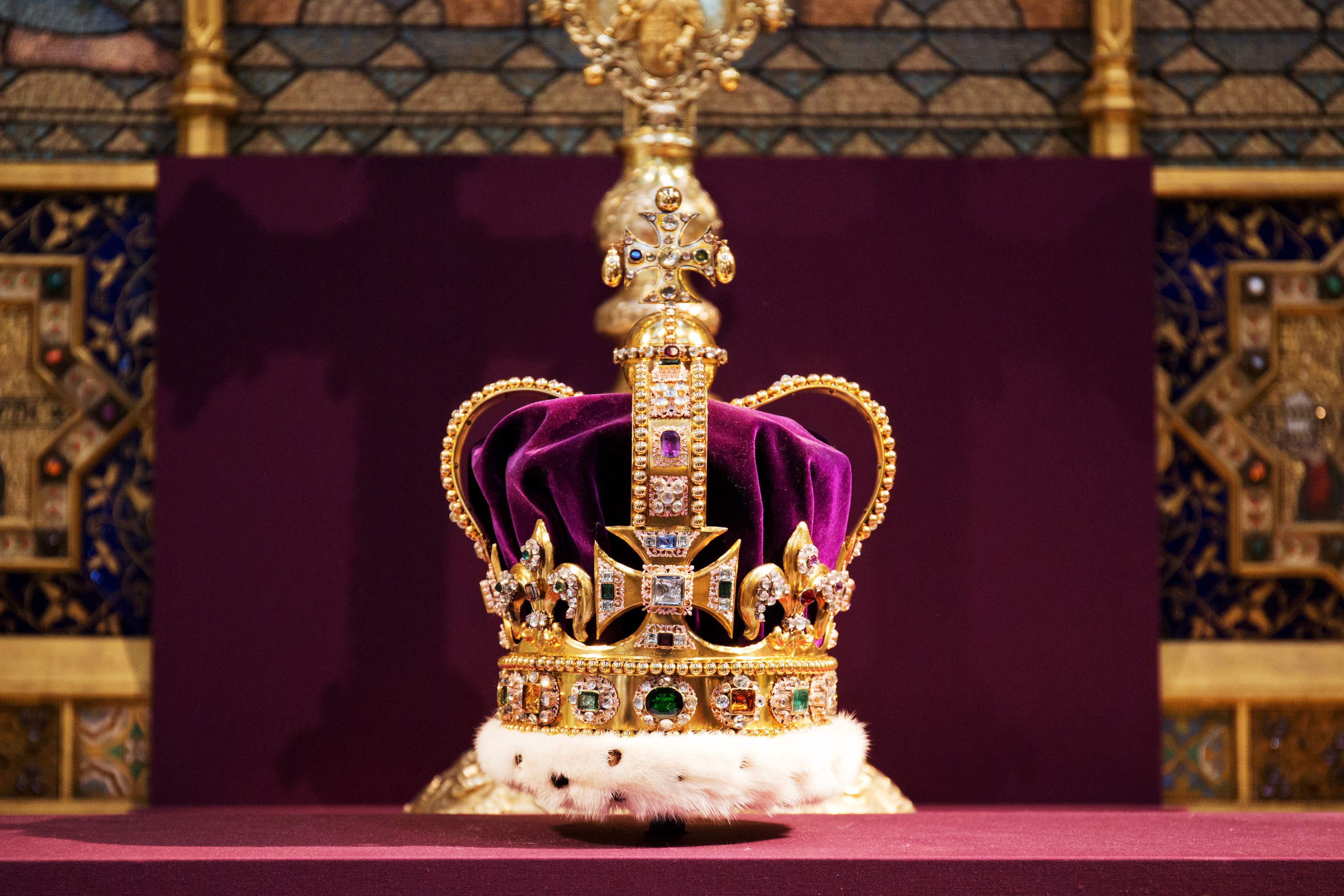
Sovereign’s Sceptre with Cross
The Sovereign’s Sceptre with Cross has been used at every coronation since Charles II’s in 1661.
It is the symbol of royal earthly power and is placed in the monarch’s right hand for the crowning.
The sceptre was transformed in 1910 for George V with the addition of the spectacular Cullinan I diamond – 530.2 carats and the largest colourless cut diamond in the world.
Sovereign’s Sceptre with Dove
This sceptre is symbolic of justice and mercy and is placed in the monarch’s left hand for the crowning.
It represents the sovereign’s spiritual role, with the dove symbolising the Holy Ghost, and traditionally has also been called the Rod of Equity and Mercy.
Made from gold, it is decorated with enamelled and gem-set collars at three intersections, surmounted by a gold monde, with an applied silver zone and arc set with rose diamonds, and a gold cross supporting an enamelled dove with outspread wings.
The rod and the sceptre are put in the King’s hands by the Archbishop.
St Edward’s Crown – The Coronation Crown
The St Edward’s Crown is used at the moment of coronation.
Weighing 2.23kg (nearly 5lb), it is the heaviest crown in the Crown Jewels.
In 1953, the then-archbishop of Canterbury Dr Geoffrey Fisher raised it aloft and placed it on Queen Elizabeth II’s head.
“By a glance she indicated it was steady,” he later recalled.
It has a solid gold frame and is set with tourmalines, white and yellow topazes, rubies, amethysts, sapphires, garnet, peridot, zircons, spinel and aquamarines, step-cut and rose-cut and mounted in enamelled gold collets, and has a purple velvet cap with an ermine band.
The crown was made for the coronation of Charles II in 1661 and was a replacement for the medieval crown, which was melted down on the orders of Oliver Cromwell in 1649 after the execution of Charles I.
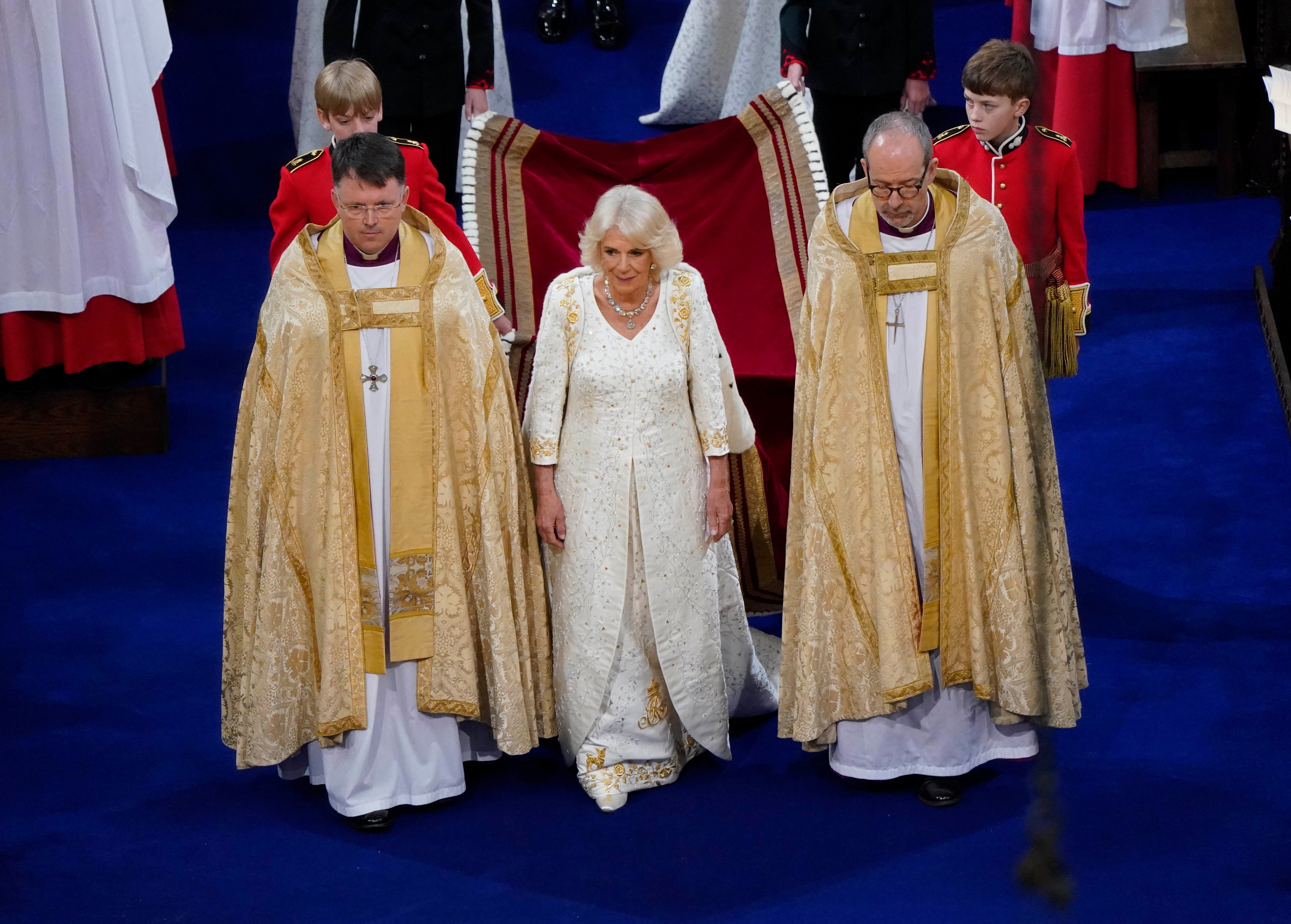
The original was thought to date back to the 11th-century royal saint, Edward the Confessor, the last Anglo-Saxon king of England.
Although it is not an exact replica of the medieval design, it follows the original in having four crosses pattee, four fleurs-de-lis and two arches.
It is St Edward’s Crown that appears in the royal coat of arms of the United Kingdom, the Royal Mail logo and in badges of the armed forces.
Under a top secret operation, the crown was briefly removed from the Tower of London to be resized to fit the King’s head.
THE QUEEN CONSORT’S REGALIA
The Queen Consort’s Ring
The ruby ring was made for the coronation of King William IV for his consort Queen Adelaide in 1831.
For previous Queens Consort, it was put on the fourth finger of their right hand, but Camilla will instead acknowledge it and it will be returned to the altar. The ring is presented by The Keeper of The Jewel House.
It has been used by three further Queens Consort; Queen Alexandra, Queen Mary, and Queen Elizabeth The Queen Mother.
Made of extended octagonal mixed-cut ruby, it has a gold setting, unbacked, within a border of 14 cushion-shaped brilliant diamonds.
Queen Mary’s Crown
Camilla has chosen to be crowned in the crown made for Charles’s great-grandmother Queen Mary for George V’s coronation in 1911.
It is the first time a consort’s crown has been recycled for a coronation rather than a new one created and could potentially be renamed Queen Camilla’s Crown in the future.
It used to feature the controversial Koh-i-noor diamond but this will not be used and the crown is being altered to include the Cullinan III, IV and V diamonds – from Elizabeth II’s personal jewellery collection.
Four of its eight detachable arches are being removed to create a different look at Camilla’s request.
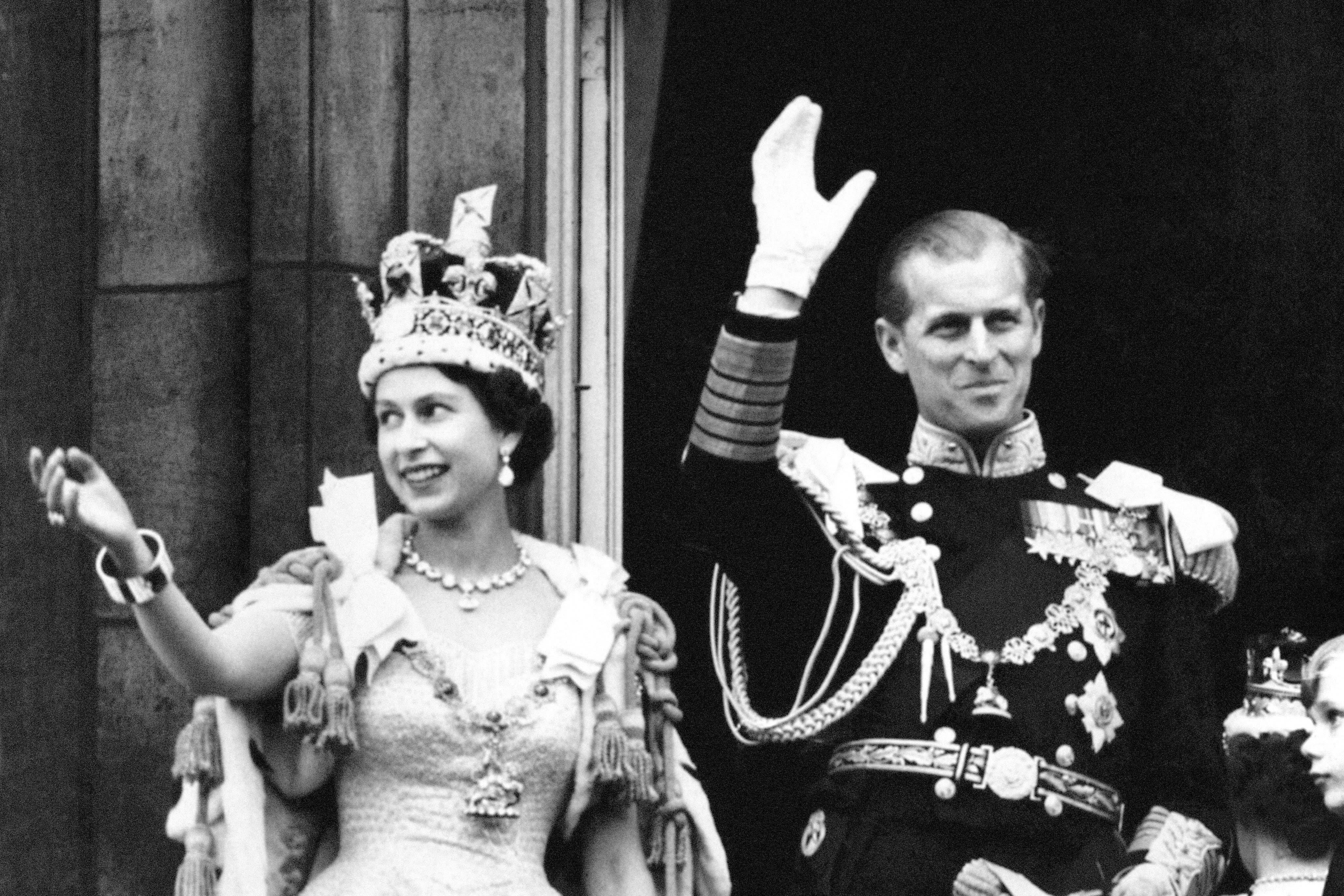
The Queen Consort’s Sceptre with Cross
Camilla will acknowledge and briefly touch the gold rod after being crowned, rather than holding it in her right hand as is tradition.
It is surmounted by a monde with a zone and arc of moulded gold set with table-cut quartzes, with a cross above mounted with rose-cut and shaped quartzes.
It represents temporal power and was originally made for the coronation of Mary of Modena, Queen Consort of James II, in 1685.
The Sceptre is presented by Lord Chartres.
The Queen Consort’s Rod with Dove
The controversial rod is made of ivory and rather than hold it in her left hand after being crowned, Camilla will acknowledge it.
Buckingham Palace said Camilla will only touch the rod and sceptre rather than holding them as is tradition.
The rod symbolises equity and mercy and the dove, with its folded wings, represents the Holy Ghost. It was also made for Mary of Modena.
The Prince of Wales has long campaigned against the trade in ivory.
The Rod is presented by the Bishop of Dover.
THE FINAL CROWN
Imperial State Crown
The King will switch from the St Edward’s Crown into the lighter Imperial Crown before he processes out of the abbey at the end of the service.
It will be the first time he has worn the famous symbol of the monarchy – which is used at State Openings of Parliament – in public.
It is known as a working crown and was also removed from the Tower of London to be resized for Charles.
It was originally made for the coronation of his grandfather George VI in 1937 and contains 2,868 diamonds, 17 sapphires, 11 emeralds, four rubies and 269 pearls and weighs over a kilogram.
Among its jewels is the Black Prince’s Ruby – one of the late Queen’s favourite gems – as well as the Cullinan II diamond and a large oval sapphire known as the Stuart Sapphire.







